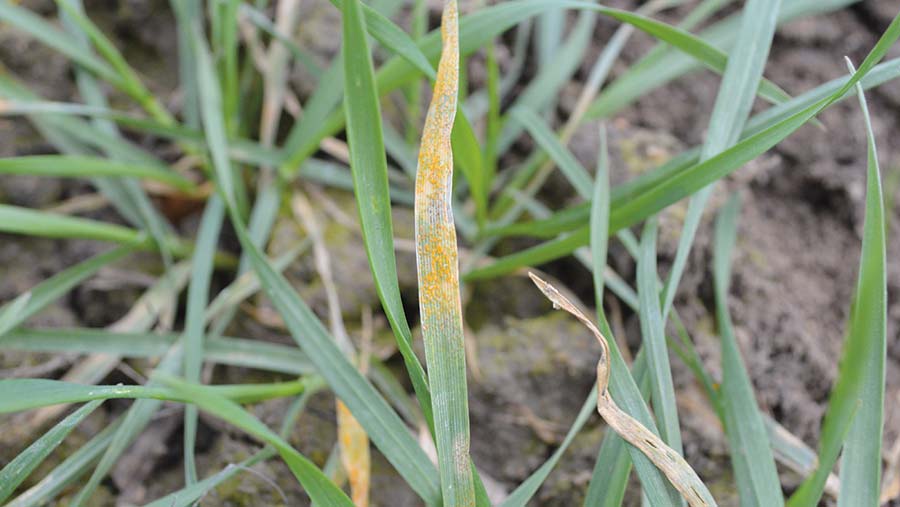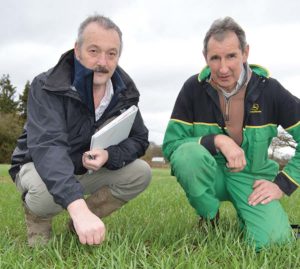Early wheat disease control vital to fight rusts and septoria

Tackling wheat disease early in the season is vital for one Oxfordshire farm manager, especially as a generally mild winter has encouraged yield-damaging yellow rust.
Spots of the disease are being seen in the winter wheat managed by Trevor Taylor and he is set to use a pre-T0 fungicide in early March to clean up his crops.
He is already planning to apply a blackgrass herbicide, so for less than £10/ha extra, an azole is to be added to keep his yellow rust-susceptible variety Gallant free of the disease.
See also: Wheat varieties get sharp downgrade in yellow rust rating
The mild weather has encouraged yellow pustules of rust, and with new races of the disease being reported and some varieties become more susceptible, the risk of disease is increasing.
“We are going through the crop with a blackgrass herbicide, so if we see disease, it is worth putting a fungicide into the tank mix,” he tells Farmers Weekly.
Rust-active azole
The fungicide will be a rust-active azole that can be mixed with herbicide Atlantis (mesosulfuron + iodosulfuron) and will be applied in early March.
Azoles prothioconazole and epoxiconazole are recommended for mixing with this herbicide.
“The weather can move against us and the crop can develop so rapidly, so it gives us peace of mind to have applied the fungicide,” he adds.
Yellow rust has a shorter life cycle than septoria, so it can move more quickly through the crop. While cold weather can slow the disease’s progress, it does not remove the threat.
The rust disease was an issue with Mr Taylor’s Gallant last season, when he used a pre-T0 spray for the first time. This approach could easily start to be routine as mild, damp winters encourage the disease.
Mr Taylor manages the 400ha Grove Farm, near Bletchingdon, six miles north of Oxford, in a five-year rotation of winter barley-oilseed rape-winter wheat-spring beans-winter wheat, and his wheat crops looked generally well coming out of a dry winter.
Later drilling
Autumn drilling has moved later on the farm’s soils – which range from light Cotswold brash to heavy clays – to allow for the control of blackgrass. Establishment started on 5 October with about 120ha of wheat finished within three days.

Syngenta’s Iain Hamilton (left) and grower Trevor Taylor
The breadmaking variety Gallant is grown partly for its early harvest, as Mr Taylor has a 400ha contract-farming operation to manage further south in Oxfordshire.
The variety has a lowly 4 resistance score for yellow rust and a 4.6 for the wet weather-loving septoria on a scale where 1 is susceptible and 9 represents good resistance.
Iain Hamilton, field technical manager with agrochemical seeds giant Syngenta, says in the group’s trial of 20 varieties on the farm last season, 18 varieties showed signs of yellow rust by December. These included Gallant, Reflection, Myriad and Zulu.
New races of yellow rust have appeared in UK crops recently, leading to the downgrading of resistance ratings for some varieties. Growers are being advised to check all varieties for rust.
Mr Hamilton argues that planning a fungicide strategy should start much earlier than the spring. “The first fungicide choice is your variety as this sets the tone for the season,” he says.
Pre-T0 sprays should be considered on wheat varieties that are susceptible to yellow rust when the disease is active in the crop and if there is mild weather to aid its spread.
Reduce inoculum
The aim should be to reduce the disease inoculum on the lower leaves, and so give flexibility on the timing of the next T0 spray, around the end of March
For a T0, Mr Hamilton’s advice is to use an azole and the multisite chlorothalonil. Only if the variety has very good resistance to yellow rust could the azole be omitted.
He says the T1 timing, typically in late April, is critical to control the reservoir of rust and septoria inoculum, and so limit disease transfer up the plant.
Last season, Mr Taylor used the SDHI-azole product Keystone (isopyrazam + epoxiconazole) at T1, but no decision has been made yet for this season.

